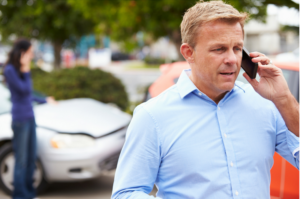 When you are in a car accident, the steps needed to document the accident are probably the last thing on your mind. Your first thoughts are probably getting treatment for your injuries and how you are going to go back to work and get your vehicle fixed. While it may not be your first thought, taking pictures after the accident can help get you full value for your injuries and property damage. The popularity of cellphones with builtin cameras make taking pictures after the accident easier than ever.
When you are in a car accident, the steps needed to document the accident are probably the last thing on your mind. Your first thoughts are probably getting treatment for your injuries and how you are going to go back to work and get your vehicle fixed. While it may not be your first thought, taking pictures after the accident can help get you full value for your injuries and property damage. The popularity of cellphones with builtin cameras make taking pictures after the accident easier than ever.
- Why are pictures important
Everyone will have their own version of events after an accident. Pictures help those who weren’t there, including insurance adjusters and juries determine the truth.
- Pictures can show who was at fault in the accident
Pictures can show details of the accident scene and damage to the vehicles. Pictures immediately after can show where debris on the road landed which might later be helpful in determining impact and fault for the accident.
- Pictures can show your injuries
It is one thing to tell an adjuster or jury that you had bruising from the accident, it is another to have pictures of the bruising. Pictures are more effective than mere words in showing pain and suffering. Photos of broken bones, slings, wheelchairs, crutches, and braces help others understand what the injury has done to your life.
- Pictures show damage to your property
Pictures are one of the best ways to show damage to your property. Take pictures of your vehicle including damage to the inside. Pictures can show airbag deployment, incursion into the passenger compartment and glass breakage. Take pictures of any other property that was damaged in the accident, such as cellphones, children’s car seats, computers, etc.
- When is the best time to take Pictures
The best time to take pictures is immediately after the accident. If pictures are taken immediately after the accident, more can be captured such as debris on the road, traffic signals and weather conditions. If you did not take pictures at the scene, you can still take pictures of your injuries, the progress of your healing, any property damage that has not been fixed and later pictures of the accident scene.
- Tips for taking pictures for your car accident
1. Take photos as soon as possible. Your first priority should be to make sure everyone is ok and that emergency services are on their. If possible, take photographs at the scene. As we stated, pictures taken immediately after the accident can show many things that will not be able to be captured at a later date such as debris on the road and weather conditions.
2. Take as many pictures as possible and from different angles.
You can not take too many photos. You never know what the pictures may later reveal. Take pictures of everything. This includes not only the cars, but also people at the scene, weather conditions, damaged objects, skid marks, the inside of your vehicle, police officers, the roadway where the accident occurred, debris on the road from the accident, stop lights, traffic signs, your injuries, and surrounding businesses.
3. Take pictures at different times of your injuries.
Take pictures of your injuries throughout the healing process. A time line of your recovery if very useful in getting full recovery for your pain and suffering. These pictures can show how long it took you to recover and the pain that was involved in that recovery.
If you would like to speak with a lawyer regarding your car accident case, please call Venus Poe at 864-963-0310.
The information you obtain in this article is not, nor is it intended to be, legal advice. You should not read this article to propose specific action or address specific circumstances, but only to give you a sense of general principles of law. Application of these general principles to particular circumstances must be done by a lawyer who has spoken with you in confidence, learned all relevant information, and explored various options. Before acting on these general principles, you should hire a lawyer licensed to practice law in the jurisdiction in which you may have a case.
